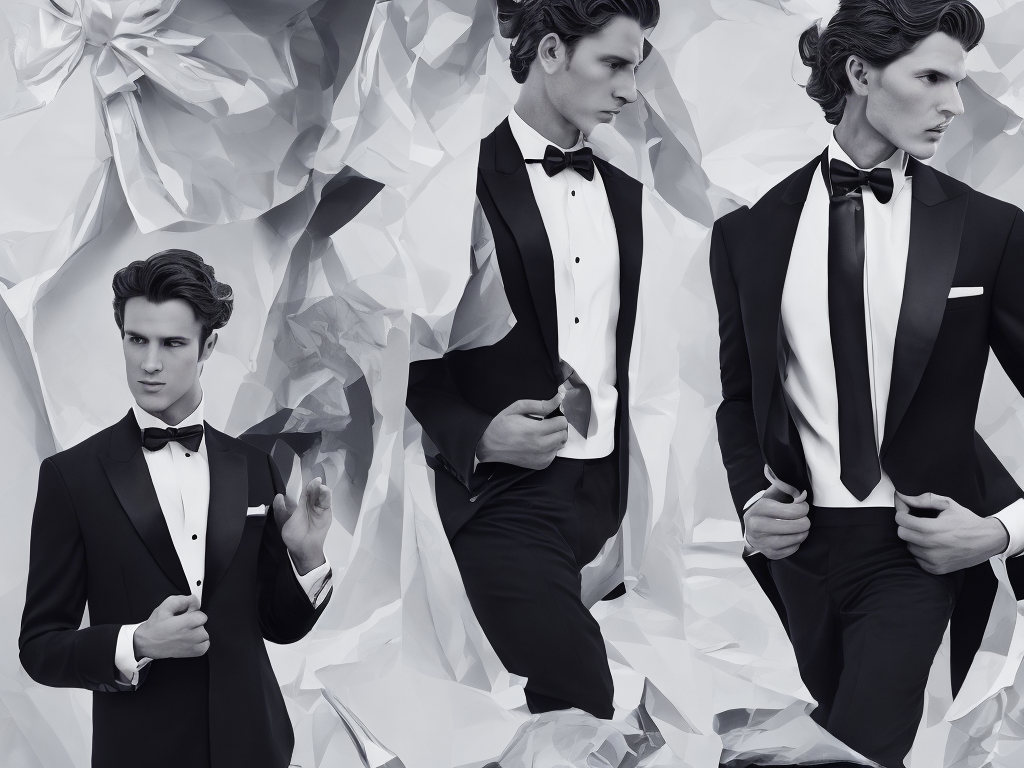
When it comes to formal wear, two options stand out: the tuxedo and the suit. At first glance, they might seem quite similar, and for a good reason too. They share certain similarities in the cut and the fabric used. However, upon closer inspection, one can see several distinct differences that set them apart.
Throughout this essay, I will outline the key differences between tuxedos and suits, explore their unique features, and discuss when each of them is suitable.
Let's begin with a brief overview of what a tuxedo and a suit are.
A tuxedo, also known as a dinner jacket, is a type of semi-formal evening wear for men. It is typically worn at formal events such as weddings, galas, and black-tie events. It consists of a black jacket with satin lapels, black trousers, a white dress shirt, and a black bow tie. On occasion, it may also include a waistcoat or cummerbund.
On the other hand, a suit is a two or three-piece set of formal wear, worn for various events ranging from business meetings to weddings. It comprises a jacket, trousers, and a dress shirt. Unlike a tuxedo, a suit generally has a more muted appearance, comes in neutral colors such as gray, navy, or charcoal, and lacks some of the decorative materials seen in a tuxedo.
Let's dive into the key differences that set these two apart.
1. Formality Level
One of the primary differences between tuxedos and suits is the level of formality they represent. Tuxedos are the epitome of formal wear, reserved for high-profile events such as red carpets, award ceremonies, and black-tie galas. In contrast, suits are a formal option best suited for business meetings, job interviews or weddings, and other formal gatherings.
2. Lapels and Finishing
Lapels are an essential part of men's formal wear. They are the folded flaps of cloth on the front of a jacket, which form a continuation of the collar. Lapels come in three styles - Notch, Peak, and Shawl - and are usually where a tuxedo and a suit differ in appearance.
Tuxedos sport satin or silk lapels, which give them their characteristic sheen and dressier appearance. The two most common lapel styles for tuxedos are peaked and shawl. The peaked lapel features a pointed edge, creating a V-shaped opening on the front of the jacket. The shawl lapel is a continuous curve, lacking the pointed edge.
A suit, on the other hand, has less formal options for lapels; it typically has peaked or notch lapels. The edges of a suit's lapels are merely folded fabric without any satin or silk finish.
3. Jacket Closures
Another significant difference between a tuxedo and a suit is the jacket closures. Tuxedos typically feature a single button closure near the waist, with a low stance. This style creates a deep V-shaped opening, giving the appearance of length and a slimming effect. In contrast, suits feature two or three buttons, with a higher stance. This style creates a more modest V-shape and a boxier silhouette.
4. Trousers
The pants worn with a tuxedo and a suit can be similar on some occasions but generally differ in several ways. Tuxedo pants have a satin stripe along the outside seam, which gives them a more formal look. Traditionally, tuxedo trousers don't have belt loops, but they do have suspender buttons on the inside waistband.
Suit trousers, on the other hand, do not have a stripe and generally have belt loops for wearing with a belt. They also have a higher waistline, which complements the style of the jacket.
5. Accessories
Accessories play a crucial role in enhancing the overall look of formal wear. A tuxedo requires particular accessories that a suit does not. Tuxedo shirts, for instance, have studs instead of regular buttons, giving them a dressier and cleaner look. Tuxedos also require bow ties, which are generally black or a matching color to the lapels, while suits allow for a wider range of tie options.
Cummerbunds and waistcoats are also commonly worn with tuxedos. These pieces serve as alternative ways of concealing the trouser waistband, providing a cleaner, more polished appearance. They are not required with suits. Lastly, tuxedos generally call for patent leather shoes that have a shiny finish, and suits pair well with more regular options such as oxfords, derbies, or loafers.
When Should You Wear a Tuxedo, and When Should You Wear a Suit?
Now that we've outlined the key differences between tuxedos and suits let's discuss when each formal wear is appropriate.
Tuxedos are reserved for formal events such as high-level corporate functions, fancy dinners, award ceremonies, and black-tie events such as galas and weddings. They are also worn to a prom or a ball. A tuxedo is meant to make a statement and exude elegance and class.
Suits, on the other hand, are versatile and can be worn to a wide array of events, including weddings, business meetings, and other formal gatherings. They are less formal than tuxedos but still create an impression of professionalism and sophistication.
Conclusion
Tuxedos and suits might seem quite similar to the untrained eye, but they have noticeable distinctions that set them apart. Tuxedos are the epitome of formal wear, reserved for high-profile events such as award ceremonies, black-tie galas, and weddings. They feature satin or silk lapels, a single button closure, and matching patent leather shoes. Suits, on the other hand, are less formal than tuxedos and are versatile. They have more neutral colors and are appropriate for a more extensive range of events.
Ultimately, whether to wear a tuxedo or a suit boils down to the nature of the event, the venue, and personal style. When choosing formal wear, it's essential to pick an option that speaks to your unique style, flatters your physique, and makes you feel confident and comfortable.
 Self-Instruct
Self-Instruct